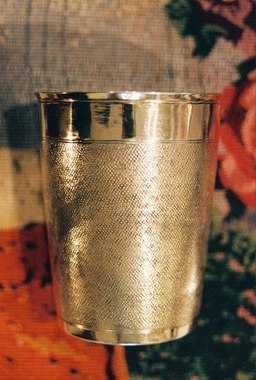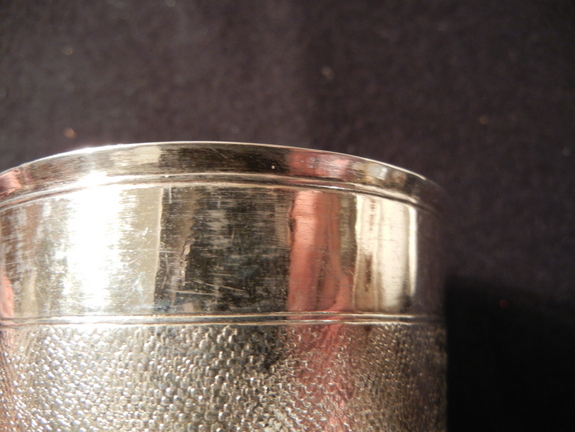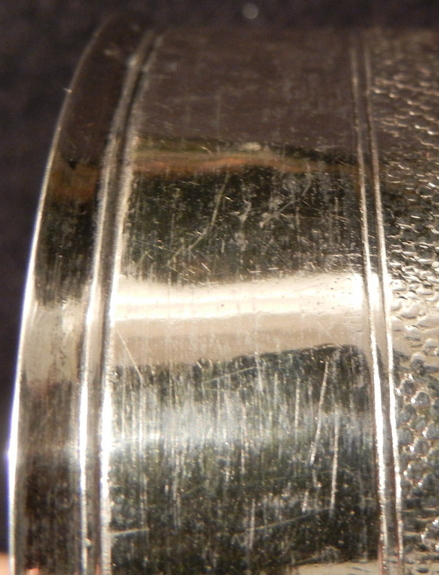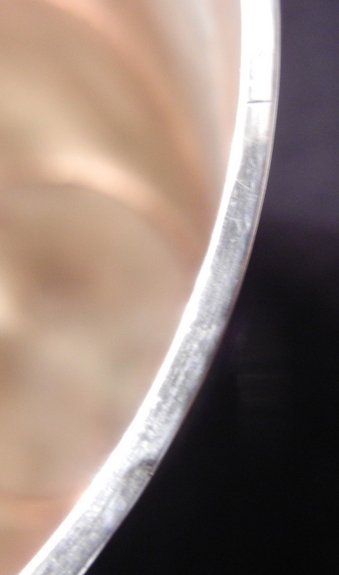|
|
|
| How to Post Photos |
REGISTER (click here)
|
|
|
|
| How to Post Photos |
REGISTER (click here)
|

|
 SMP Silver Salon Forums SMP Silver Salon Forums
  Continental / International Silver Continental / International Silver
  German Beaker? German Beaker?
|
| next newest topic | next oldest topic |
| Author | Topic: German Beaker? |
|
ahwt Posts: 2334 |
  
 We found this beaker last week in a newly discovered (for us) Antique Shop. The beaker has a gold wash on the inside and has very attractive "design" on the outside that has a shagreen pattern look. Would this be considered a form of engine turning? It appears to me that this engraving would be difficult to do and I am not sure that one should call it an engraving. In any event the effect is a textured look in appearance that is very attractive. It also feels good in the hand. I wonder if this beaker is German in view of the zigzag marks. I have often wondered what the purpose of the zigzag mark is. Where they simply part of that assaying process? Any information about this cup would be appreciated. The letters in the mark with the crossed swords are S and F. IP: Logged |
|
blakstone Posts: 493 |
  
This is what is known as a "serpent scale" beaker. The effect was produced by hammering the surface all over with a very small oval or circular punch. It was a very popular design for silver cups in Germany & middle Europe in the 17th & 18th centuries. The zigzag line, known by the unlikely name of a "diet" in English, is called a "Tremolierstich" in German. (I like the term "proofstrike", which I see occasionally in English translations of German catalogues; much better than the peculiar "diet".) It was produced when an assayer removed a bit of silver with a rowel-like device in order to test the content for purity. As for the marks, they do not look familiar to me. They are consistent with marks anywhere from the early 17th century to the mid-19th century, as is the style of the beaker, so putting any date on it at all for the moment is impossible. If genuine (many 19th century items have spurious pseudo-marks), almost certainly one mark is the maker's mark and the other the guild/city/assayer's mark. I can't really make them out; could you perhaps post a better, more detailed close-up of the marks? [This message has been edited by blakstone (edited 11-21-2004).] IP: Logged |
|
ahwt Posts: 2334 |
  
 I think that is the best picture I can come up with now. The initials S F are with what look like crossed swords. Thank you for the interesting information, in particular on how the surface was made and the assay method. IP: Logged |
|
labarbedor Posts: 353 |
  
The one mark is Basel Switzerland the maker's mark is Sebastian Fechter master 1673 died 1687. Countries took metal off a piece of silver to be tested in different manners some more visible than others. The Germanic countries were probably most obvious. But if you look on the bottom of many English Georgian pieces like a oval teapot or a meat platter, you will see a large flat scraped area, where they took off metal to be tested. IP: Logged |
|
ahwt Posts: 2334 |
  
Thanks for the great information. I must make a clarification to my first entry. Actually what happened at the antique shop was my wife handed me the beaker and the little dog pictured below and said "We should buy these". After 41 years of marriage I know that we should. The little red ware ram has a whistle at one end and we are still looking through books as to what it is. IP: Logged |
|
vathek Posts: 966 |
  
for another look at a zigzag test mark see my post below 17/18th c Swedish bowl? IP: Logged |
|
ahwt Posts: 2334 |
  
   It has been nasty weather here and I started looking at a couple of items that I brought some years ago. On this beaker I noticed that the upper rim in not at all like those I have from the U.S. The top of the rim is perfectly flat and from the side looks like a ceiling moulding (but not concave or convex) that goes straight to a half round moulding. I do not know how this was made, but it was either fashioned separately and then applied or it was formed by hammering on the partially finished beaker. Any ideas? IP: Logged |
|
Hose_dk Posts: 400 |
  
How did they take off material to test? The zigzag stribe was used in Germany and many other countries. In Denmark the guardein had a set of needles in different lod. They took a testing stone - probier steine - a Black flat stone and scratched the silver against the stone. Then the guardein scratched the needle Next to it. By comparing they could determine the silver content. Silver is White - the more copper in the silver the more red colour. The test mark where not supposed to be hidden they should be seen. They showed that the item was tested. Some below that the zigzag stribe is part of the prof. That is not correct. The prof is the hallmark. The zigzag stribe shoves that it is tested - but NOT the test result. Only the guardein mark states the prof. The decoration. It has various names. In Germany "schlangenhaut" snakeskin pattern In Denmark its called "nålepunslet" i.e. needle punched. The horse - in Denmark its called "pib i røv hest" i.e., Blow in the ass horse I know many cultures even back to the Greek and Roman empires. Lerfløjter a commercial link in Danish. (translated) I have a bird. You fill the bird with Water (I cannot see if you can put Water into the horse) If you can't fill with Water its a whistle. The Water inside change the sound - it becomes a trille - Google translate trillefløjte into whistle. ant that's not what I am looking for. The sound (with the Water) becomes different highs sound like a bird singing. IP: Logged |
|
ahwt Posts: 2334 |
  
Thanks for the information Hose-dk. I missed this when you posted it. And thanks for the translation link to the interesting whistles. The one I have is a ram, but it is the same idea. [This message has been edited by ahwt (edited 07-28-2015).] IP: Logged |
|
agleopar Posts: 850 |
  
Art, the rim on your beaker was probably made the second way you guessed. As the cup is being raised, after about 1/2 the height is gained, the rim is made parallel to the base and then "caulked" (this is the English term) with a cross peen hammer. Caulking, done every subsequent raising, thickens the rim and with skill and care can be done so that the thickness goes down the side for a 1/4 inch. After it would have been put on a rudimentary lathe and the "molding" cut in. The other way is to solder on an already shaped wire to the thin finished rim but one would need fancy draw plates or swages to make the wire, both used later when the technology of the industrial revolution made those things affordable to more smiths. These also saved time because the caulked rim is a skilled art... but that labor was the cheap part in the 1600's! IP: Logged |
|
ahwt Posts: 2334 |
  
Agleopar thank you so much for the clear explanation. This is the oldest cup that I have and I can imagine the silversmith patiently raising the cup and gradually forming the top rim. It has another feature that I like and that is the gold wash interior that somehow is different that modern ones. It has a deeper glow to it giving it more depth and a slightly different color than modern ones. It is a fun cup to look at. IP: Logged |
All times are ET | next newest topic | next oldest topic |
  |
|
Ultimate Bulletin Board 5.46a
|
1. Public Silver Forums (open Free membership) - anyone with a valid e-mail address may register. Once you have received your Silver Salon Forum password, and then if you abide by the Silver Salon Forum Guidelines, you may start a thread or post a reply in the New Members' Forum. New Members who show a continued willingness to participate, to completely read and abide by the Guidelines will be allowed to post to the Member Public Forums. 2. Private Silver Salon Forums (invitational or $ donation membership) - The Private Silver Salon Forums require registration and special authorization to view, search, start a thread or to post a reply. Special authorization can be obtained in one of several ways: by Invitation; Annual $ Donation; or via Special Limited Membership. For more details click here (under development). 3. Administrative/Special Private Forums (special membership required) - These forums are reserved for special subjects or administrative discussion. These forums are not open to the public and require special authorization to view or post. |
|
copyright © 1993 - 2022
SM Publications
All Rights Reserved. Legal & Privacy Notices |